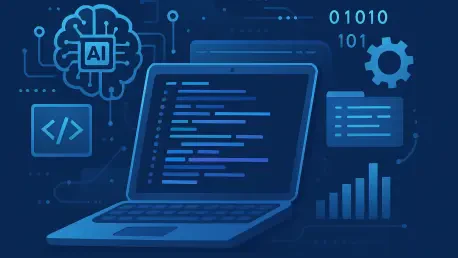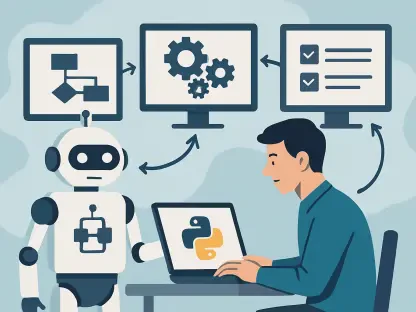In the rapidly evolving landscape of software development, AI coding agents have become indispensable tools, promising to streamline workflows and boost productivity with remarkable efficiency. However, a recurring challenge persists: while these agents can generate code that appears functional at first glance, it often falls short of the intended purpose, leading to frustration and wasted effort. This discrepancy is particularly evident when building complex, mission-critical applications or integrating with established codebases, where precision and reliability are paramount. The root of the issue lies not in the technology itself, but in how developers interact with these powerful tools. By shifting the approach to treat AI agents as literal-minded collaborators rather than mere search engines, a more effective partnership can be forged. This is where spec-driven development emerges as a transformative methodology, with specifications acting as dynamic, executable guides that evolve alongside projects. Enter Spec Kit, a newly released open-source toolkit designed to integrate this structured process into workflows with popular AI tools like GitHub Copilot, Claude Code, and Gemini CLI, promising to bridge the gap between intent and implementation.
1. Understanding the Challenges of AI Coding Agents
The rise of AI coding agents has revolutionized how developers approach prototyping and ideation, offering rapid code generation based on high-level prompts. However, this often results in a phenomenon dubbed “vibe-coding,” where the output looks plausible but fails to meet specific requirements. Issues such as non-compiling code, misaligned intent, or incompatible architectural choices are common, especially in scenarios involving existing systems or critical applications. These shortcomings highlight a fundamental mismatch between expectation and delivery, as agents may prioritize common patterns over nuanced needs. For developers tackling intricate projects, this can lead to significant rework, undermining the initial promise of efficiency. The frustration stems from a lack of clear communication, as vague instructions leave room for misinterpretation by even the most advanced AI models. Addressing this gap requires a rethinking of how goals are conveyed to ensure outputs align with precise objectives.
Spec-driven development offers a compelling solution by reframing the role of specifications in the coding process. Instead of static documents that are written once and forgotten, specs become living artifacts that serve as the central source of truth throughout a project’s lifecycle. This approach ensures that every step, from ideation to implementation, is grounded in a shared understanding of purpose and requirements. By leveraging Spec Kit, developers can harness AI agents more effectively, transforming ambiguous prompts into actionable, reliable outcomes. This toolkit integrates seamlessly with leading coding agents, providing a structured framework to guide the development process. The shift from ad-hoc prompting to a systematic methodology marks a significant step forward in mitigating the pitfalls of AI-driven coding, paving the way for more dependable results across diverse applications.
2. Defining Spec-Driven Development with Spec Kit
At the core of spec-driven development lies the principle that specifications should drive every aspect of the engineering process, from initial concept to final implementation. Spec Kit embodies this philosophy by positioning the spec as the heart of development workflows, guiding task breakdowns, checklists, and code generation while developers focus on strategic oversight. Unlike traditional methods where specs are often sidelined after creation, this toolkit ensures they remain active tools for validation and refinement. The process is designed to maximize the strengths of AI coding agents by providing clear, unambiguous direction, reducing guesswork, and enhancing output quality. With compatibility across platforms like GitHub Copilot, Claude Code, and Gemini CLI, Spec Kit offers a versatile solution for modern development challenges.
The methodology unfolds in four distinct phases, each with specific objectives and validation checkpoints to ensure alignment before progressing. In the first phase, developers provide a high-level overview of the project’s purpose and goals, allowing the coding agent to craft a detailed specification focused on user journeys, experiences, and success metrics. This living document captures who the users are, the problems being solved, and the desired interactions and outcomes. The second phase shifts to technical planning, where developers specify the stack, architecture, and constraints, resulting in a comprehensive blueprint that respects company standards or integration needs. Multiple plan variations can be generated for comparison, ensuring flexibility. The third phase breaks down the spec and plan into small, testable tasks, each addressing a specific component for isolated implementation. Finally, the execution phase sees the agent tackling tasks with focused changes, guided by the spec and plan, while developers verify and refine at each stage to address gaps or edge cases.
3. Integrating Spec Kit into Agentic Workflows
Adopting Spec Kit into existing agentic workflows is a straightforward process that enhances the precision of AI coding agents through structured commands. Compatible with tools like GitHub Copilot, Claude Code, and Gemini CLI, the toolkit simplifies the transition to spec-driven development by offering intuitive steps to guide agents in generating necessary artifacts. The setup begins with installing the specify command-line tool using the command: uvx --from git+https://github.com/github/spec-kit.git specify init . This initializes the project structure, laying the foundation for a systematic approach. Subsequent commands steer the agent through defining the project’s purpose with /specify, creating a technical blueprint with /plan, and generating actionable tasks with /tasks. This methodical progression ensures that vague prompts are transformed into clear intent, enabling reliable execution.
Beyond the initial setup, the benefits of this structured workflow become evident in the clarity it brings to complex projects. By focusing on the “what” and “why” during specification, developers ensure the agent captures the essence of the project before delving into technical details. The planning phase allows for tailored architectural decisions, aligning outputs with organizational standards or constraints. Task generation further refines the process by breaking work into manageable chunks, facilitating easier review and validation. This approach not only minimizes errors but also streamlines collaboration between human oversight and AI capabilities. As a result, developers can confidently navigate intricate requirements, knowing that each phase builds on a solid foundation of intent and technical direction, ultimately leading to more cohesive and effective software solutions.
4. Exploring the Success Factors of Spec-Driven Development
The effectiveness of spec-driven development hinges on its ability to provide clarity where traditional prompting often fails. AI language models excel at pattern completion but struggle with ambiguous instructions, leading to assumptions that may not align with specific needs. By offering a detailed specification, a technical plan, and focused tasks, Spec Kit eliminates much of the guesswork, ensuring that agents understand exactly what to build and how to approach it. This structured guidance results in fewer errors and more consistent outputs, even across diverse technology stacks like Python, JavaScript, or Go. The universal challenge of translating intent into functional code is addressed through a process that prioritizes precision at every stage, making it a robust solution for varied development environments.
For larger organizations, this methodology offers additional advantages by centralizing critical requirements within the specification and plan. Security policies, compliance rules, and design system constraints are no longer scattered across disparate sources or reliant on individual knowledge; instead, they are embedded from the outset, accessible to the AI for informed decision-making. The iterative nature of spec-driven development further enhances its appeal, as updates to the spec can trigger regenerated plans and tasks without locking teams into early, inflexible choices. This adaptability supports rapid experimentation and course correction, reducing the risk of costly rewrites. By fostering a balance between stability in intent and flexibility in execution, the approach empowers teams to tackle complex projects with confidence and efficiency.
5. Identifying Key Scenarios for Implementation
Spec-driven development shines in specific scenarios where clarity and structure are critical to success. For greenfield projects, often referred to as zero-to-one initiatives, investing time upfront in crafting a spec and plan ensures that AI agents deliver solutions tailored to the intended vision rather than generic templates. This proactive step prevents misalignment early on, setting a strong foundation for new endeavors. Similarly, when adding features to existing systems—termed N-to-N+1 development—the approach proves invaluable. A detailed spec clarifies how new functionalities integrate with current architectures, while the plan ensures consistency with established constraints, resulting in seamless, native-feeling additions that enhance rather than disrupt.
Another compelling use case lies in legacy modernization, where original system intent may be obscured by time. By capturing essential business logic in a modern spec and designing a fresh architecture through the plan, developers can leverage AI to rebuild systems without inheriting outdated technical debt. Across all these scenarios, the core advantage remains the separation of the stable “what” from the adaptable “how,” enabling iterative development and experimentation without the burden of extensive overhauls. This flexibility allows teams to test multiple versions and refine approaches quickly, ensuring that solutions evolve in step with changing requirements or insights. The structured nature of spec-driven development thus offers a versatile framework for addressing both innovative and maintenance-driven challenges in software engineering.
6. Looking Ahead to Evolving Development Paradigms
The trajectory of software development is shifting from viewing code as the ultimate source of truth to prioritizing intent as the guiding force, a transition made tangible through AI-driven specifications. With tools like Spec Kit, specs are no longer passive documents but executable artifacts that directly influence what gets built, shaping outcomes with precision. This open-source experiment underscores that the true innovation lies in the process itself, rather than any single platform, opening doors for widespread adoption across the industry. As AI continues to redefine workflows, the emphasis on intent ensures that human creativity remains at the forefront, translated effectively into functional software through structured collaboration with technology.
Future explorations in this domain are poised to enhance usability and integration, addressing practical challenges faced by developers. Considerations include making workflows more engaging to avoid the monotony of dense text, exploring seamless integrations with environments like VS Code for a more intuitive experience, and enabling comparisons between multiple implementations to foster creative iteration. Additionally, managing specifications and tasks at scale within organizations remains a key focus, as streamlined organizational tools could significantly boost efficiency. Community input is vital to refining these aspects, ensuring that spec-driven development evolves to meet diverse needs while maintaining its core promise of aligning AI capabilities with human intent for transformative results.
7. Reflecting on a Path Forward with AI-Driven Innovation
Spec-driven development, as embodied by Spec Kit, marks a pivotal moment in harnessing AI to bridge the gap between human creativity and functional software solutions. This approach redefines how developers collaborate with coding agents, ensuring that intent drives outcomes through structured specifications and plans. Looking back, the journey highlights a successful shift toward precision and reliability in development workflows, addressing longstanding challenges with vague prompts and misaligned outputs. The open-source nature of the toolkit fosters a collaborative spirit, inviting diverse perspectives to shape its evolution and application across varied projects.
Moving forward, the focus turns to actionable next steps, such as refining user experiences to make the process more intuitive and exploring deeper integrations with popular development environments. The potential to compare implementations and manage complex specifications at an organizational level opens new avenues for scalability and innovation. Developers and teams are encouraged to experiment with this methodology, leveraging its flexibility to tackle both novel and legacy challenges. As the industry continues to evolve, spec-driven development stands as a foundation for future advancements, promising to empower creators by aligning AI tools with the nuanced demands of real-world software engineering.









